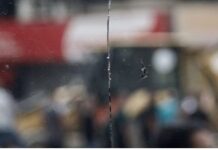Ayah Kutmah
The Nation / June 30, 2023
Guantánamo and Israeli military courts have the same goal: to make lawful systems of fair trial violations, torture, and arbitrary and indefinite detention.
GUANTÁNAMO BAY—Tall chain-linked fences topped with coiled barbed wire encircle a complex of trailers and mobile units that form Guantánamo’s war courts. No complete public rendering of the camp exists: The bare exterior and high-tech interior are classified. Formally known as the “Expeditionary Legal Complex,” unironically named “Camp Justice,” the US government built the military encampment to put on trial the individuals captured, tortured, and indefinitely detained in America’s War on Terror.
“In any real court in America,” defense lawyer Annie Morgan explained to me, she would have access to basic client information, such as medical records. But Guantánamo’s special tribunal allows the government to withhold any information from the defense as classified. CIA interrogators tortured her client, Abd al-Rahim al-Nashiri, in black sites across the globe for nearly four years before his transfer to Guantánamo in 2006. Al-Nashiri was sodomized, waterboarded, and put through mock executions. Pretrial proceedings, now in their 12th year, persist in his case related to the bombing of the USS Cole, in which the alleged war crimes occurred a year before the President George W. Bush administration launched his War on Terror.
At Camp Justice, the military judge, dressed in civilian robes, sat indifferent in the makeshift chamber. Soldiers lined the perimeter of the room, with some standing behind us as we watched the proceedings of a court from behind three panes of soundproof glass and a 40-second audio delay. I attended the week of proceedings as a media observer, subject to strict rules and ever-shifting protocols.
When I first entered the military camp, I walked through the maze of wire, checkpoints, and trailer units struck by a feeling of déjà vu. The scene at Gitmo was a near replica of a visit, two years earlier, to the Israeli Ofer Military Court in the occupied West Bank. At Ofer, tall concrete walls enclose the military base and its trailer courts, which are built of the same non-permanent material at Gitmo but smaller—more like shacks. In 2021, I attended a session in the trial of Palestinian human rights activist and director of the Health Workers Committee Shatha Odeh.
At Guantánamo, there’s more pretense. They have kangaroo courts, but with high-tech interiors, civilian dress, and protracted battles between defense and prosecution. The Israeli military courts, however, don’t pretend. Trials take place in cramped trailers and often last just minutes, and the conviction rate is over 99 percent.
Both the US and Israeli military courts are the creations of invented ad hoc military judicial systems. They have different war logics—a global war on terror vs. foreign military occupation—but they have the same goal: to make lawful systems of fair trial violations, torture, and arbitrary and indefinite detention.
The paradox of legality and illegality are key. The United States and Israel base their right to create these courts on different subsets of international law—the laws of armed conflict and occupation, respectively—that permit the use of military tribunals under limited mandates. By the same legal tongue-twist, they are upheld as “temporary” and “exceptional” systems; hence, the non-permanent trailer courts. But neither court system has an expiration date. The Israeli military judicial system, tied to the 1967 occupation of the West Bank and Gaza, is over 50 years old, and the Guantánamo military commissions, a post-9/11 creation, are over 20. They are innovations justified by belabored legal rationales. They pervert domestic and international law, create new categories of exceptions, and sometimes even deny the law altogether. And they’ve found inspiration in each other.
Jamil Dakwar, the director of the ACLU’s Human Rights Program and a former senior attorney with the Palestinian rights’ group Adalah, first visited the Israeli Ofer detention camp on behalf of Adalah more than two decades ago. “It literally looked like the first tents of Guantánamo,” he told me, “without the blindfolding, shackling and sensory deprivation devices, but they were similar images of creating a detention camp from scratch.”
Ofer detention camp opened in 2002, following the Israeli occupation’s reinvasion of major Palestinian cities in the West Bank during the Second Intifada. Between 2002 and 2005, Israeli occupation forces arrested tens of thousands of Palestinian men, women, and children. The Israeli military built the camp to house the Palestinian detainees who were now so great in number that they no longer fit in existing Israeli prison facilities. Along with other rights’ groups, Adalah successfully petitioned the Israeli High Court to allow external monitors into Ofer. They challenged the camp’s legality and conditions, which Dakwar described as, “cruel and inhumane treatment, amounting to torture in some instances.”
Near the detention camp were the newly relocated military courts, recounted Sahar Francis, the director of Addameer Prisoner Support and Human Rights Association. The Israeli occupation housed detainees en masse in open-air cages and took them to court sessions held in tents. Lawyers struggled to keep up with the number of cases. For more than 20 years, Francis has represented thousands of Palestinians tried before the Israeli military courts. She described the expansion of military orders that criminalized nearly all aspects of Palestinian life. The Israeli occupation forces prosecute everything from traffic incidents to membership in a student union to “incitement” on social media in the military courts. The extraterritorial jurisdiction of the courts is attached to the Palestinian people, not the land: Illegal Israeli settlers in the West Bank are prosecuted in Israeli civil courts. Francis has watched Ofer morph into a permanent military base, prison, and the larger of the two Israeli military courts, which together try thousands of Palestinians every year.
In Guantánamo, the first military commissions were held in 2004 in a building that once housed a dentist’s office. The trials were a “failed experiment from the start,” said Dakwar who went down on behalf of the ACLU. The United States created the commissions to secure convictions. It favored the prosecution by creating new categories of charges and relying on confessions extracted by torture. The Bush administration argued that neither the Constitution nor the Geneva Conventions applied in Guantánamo, but the Supreme Court struck down Bush’s first military commissions order, prompting Congress to legislate the tribunal under the Military Commissions Act of 2006. The act was amended in 2009, after another Supreme Court ruling struck that down in part too. Each change was an attempt to reconfigure a system that could accommodate secret information and coerced testimony. “Every case before the military commissions is predicated on torture,” Morgan told me. Over a decade later, her team continues to litigate a case where the government openly uses evidence derived from torture.
Before the invention of the military commissions, the US government tried to change the definitions of torture to make it fit the law. In her book The War in Court: Inside the Long Fight Against Torture, Lisa Hajjar explains how the Bush administration looked to Israel to help it generate legal rationales for torture. Israel, Hajjar points out, was “the first government to publicly claim the right to use violent interrogation techniques as a legitimate prerogative to protect national security.”
The Israeli legal system has repeatedly litigated and legitimated the torture of Palestinian detainees. Routine practices employed by Israeli interrogators—extreme stress positions, beatings, sleep deprivation, inhuman conditions—were relegated as not rising to the level of torture, whereas more violent torture methods were allowed under an expansive “ticking bomb” scenario. In drafting the US torture memos, John Yoo borrowed language from the 1987 Israeli Landau Commission, which defined practices of “moderate physical pressure” that did not constitute torture. An August 2002 memo from the Department of Justice cites a 1999 Israeli High Court decision that carved out a “necessity defense” permitting violent interrogation methods. Dual principles of proportionality and necessity were crafted by the US and Israel to violate the absolute prohibition of torture under international law and immunize officials from prosecution. Torture itself then becomes “secret information” in both military court systems, cementing impunity for all involved.
There were other times when the influence of legal apologia moved from the United States to Israel. After 9/11, the US invented a new category of person: the “unlawful enemy combatant,” who was neither civilian nor combatant and could therefore be stripped of prisoner of war protections under the Geneva Conventions. The term first appears in a November 2001 military order authorizing indefinite detention without trial and laying the groundwork for the military commissions. Two months later, the US opened Guantánamo. Each new military commissions act renewed the unique status of “unlawful combatants” to permit the continued indefinite detention of remaining prisoners.
During this period, Israeli authorities struggled to justify the illegal detention of two Lebanese nationals held for over 10 years as bargaining chips after an Israeli High Court decision ruled against their administrative detention. Once the US codified a new special status, the Israeli Knesset quickly passed its own Unlawful Combatants Law in 2002, retroactively applying it to the case of Lebanese hostages. The law, Francis noted, is “even more draconian” than the administrative detention laws that allow the Israeli regime to hold individuals, almost exclusively Palestinians, without charge or trial. After 2005, the same law became the basis for the indefinite detention of Palestinians from Gaza, who now fell under a distinct legal status, adding to the patchwork of legal regimes undergirding the Israeli military judicial system.
The supposedly “temporary” ad hoc military judicial regimes have become outliers—often termed sui generis—in the international legal system. Francesca Albanese, the UN special rapporteur on the situation of human rights in the Palestinian Territory occupied since 1967, finds the classification misleading. “By giving [the occupation and courts] an exceptional sui generis label, we normalize what should be a manifestation of illegality,” she told me. An entrenched Israeli occupation is unlawful, she pointed out, as is a military judicial system that serves as its executive tool for the subjugation of the Palestinian people.
Still, both military courts simultaneously espouse and reject the law under a guise of exceptionality. What we must always remember is that these systems are predicated on power, not adherence to the rule of law. Temporary and exceptional legal regimes become the purveyors of war crimes and crimes against humanity. The UN Working Group on Arbitrary Detention recently published a call for the release of Abu Zubaydah, one of the “forever prisoners” tortured by the CIA. It identified systematic violations at Guantánamo that “may constitute crimes against humanity.” Addameer currently represents the cases of three Palestinian child prisoners before the International Criminal Court.
Five thousand Palestinians are currently held in Israeli jails, among them over 1,000 indefinitely detained without charge or trial, the highest number since 2003, amid a widespread crackdown by Israeli occupation forces that killed at least 156 Palestinians in 2023. New Israeli military orders outlaw even human rights organizations—including Addameer—that represent prisoners. In a twist of irony, they are now designated “terrorist organizations,” subject to arrest and prosecution by the same military courts.
The legal poisons of the US’s War on Terror and Israeli settler-colonialism and apartheid are still being concocted with transnational consequences. The Biden administration says it wants to close Guantánamo, even as the military commissions trudge forward debilitated by a legacy of torture and government secrets. Thirty detainees remain, including 16 eligible for transfer and three forever prisoners. When I left Guantánamo, a new $4 million trailer courtroom was under construction. The legal and physical architecture of Guantánamo remain as a warning to—or in the wrong hands, a model for—future US administrations and governments globally.
Ayah Kutmah is a writer and researcher with a focus on prisoners’ and human rights in the Middle East; she previously worked with Addameer Prisoner Support and Human Rights Association












